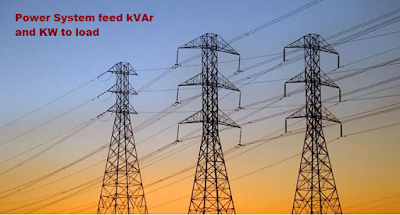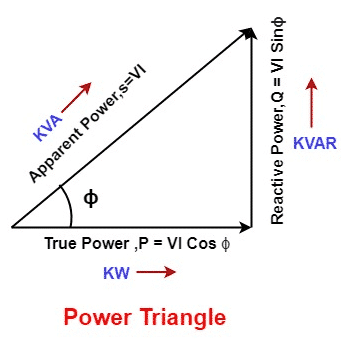kW is the unit of active power that is consumed by the load for doing real work. The real power drawn from the system is also known as an active power or average power. kVA is the apparent power drawn from the supply source for the functioning of the electrical equipment. The electrical equipment draws reactive power to meet its magnetizing current requirement.

To understand the concept of apparent power, let the concept of reactive power be understood first. The equipment that functions on the magnetic principle always draws reactive power, known as kVAr. The kVAr is the power that is not consumed by the equipment but is stored in the system.
The reactive elements like inductors, capacitors,s and non-linear loads like a diode, bipolar junction transistors, MOSFETs, IGBTs, etc., draw reactive current from the supply source. These electrical components consume reactive power(kVAr), but these do not consume real power except some minor active power. Thus, the inductor, capacitor, and nonlinear loads draw reactive power(kVAr) from the supply source.
When an inductor is connected to an alternating supply source, it draws current, which lags the voltage by 90 degrees. The active power drawn by the inductor is zero; the inductor draws only reactive power (kVAr) except for very minor active power in the form of heat loss.
Similar to an inductor, when a capacitor is connected to an alternating supply source, it draws current, which leads the voltage by 90 degrees. The active power drawn by the capacitor is zero. The capacitor draws only reactive power (kVAr) except very minor active power in the form of heat loss.
The reactive components inductor and capacitor do not draw any real or active power from the system. Still, these circuit components draw current from the system to meet their reactive power(kVAr) requirement. Thus, the total current drawn from the supply source is the vector sum of the active and reactive current. The concept of all three types of power-active power(kW), reactive power(kVAr), and apparent power(kVA) can be well understood with the power triangle diagram.

From the above power triangle,
The relationship between kW, kVAr, and kVA is as follows.

Where,
kVA – Apparent Power
kW – Active Power
kVAr – Reactive Power
The relationship between kW, kVAr, and kVA is as follows.
If the reactive current drawn is zero, the apparent power is equal to the real or active power. In the case of the resistive loads, the reactive current is zero, and the real power and the apparent power are equal.
In the case of the inductive and capacitive loads, the apparent power(kVA) is always more than the active power. The apparent power increases with an increase in the reactive power with the same active power. The power factor gets lowered with an increase in the reactive power.
Relation between KVA and KW
The relation between KVA and KW for single-phase and three-phase AC circuits is given below.
Single Phase Circuit- kVA and kW
The relationship between apparent power and active power is given below.

Where,
CosΦ is the power factor.
The power factor is unity for the resistive loads, and thus, the kVA is equal to the kW.

The inductor and capacitor current lags and leads the voltage by 90 degrees, respectively. For single phase circuit, the active power drawn by the inductor is;

Thus, the active power drawn by the pure inductor is zero. For single phase circuit, the reactive power drawn by the inductor is;

Thus, the pure inductor draws reactive power only. A similar case is with capacitors. The capacitor also draws zero active power. It draws only reactive power.
Three Phase Circuit- kW and kVA
For a three-phase circuit, the phase voltage is about 58 % of the line voltage.

The active power(P) in a three-phase circuit is;

Where,
V = Line-to-line voltage
I = Line current
The reactive power(Q) in a three-phase circuit is;

The apparent power(S) in a three-phase circuit is;

Where,
S is apparent power.
The electrical equipment always draws reactive power for equipment functioning and active power for delivering useful work. Some of the electrical equipment ratings are specified in apparent power(kVA)
The manufacturer specifies the transformer and alternator rating in kVA because he does not know at what power factor the user will operate the equipment.
Kw to kVA Calculations
The KW to KVA conversion formula is,

Where,
- KW- Real Power or Active Power
- KVA – Apparent Power
- PF – Power Factor
kVA to kW Calculations
The KW to KVA conversion formula is,

Where,
- KW- Real Power or Active Power
- KVA – Apparent Power
- PF – Power Factor
Solved problems on kW and kVA
A balanced three-phase load draws 100 KW power at a power factor of 0.90. The system line-to-line voltage is 440 Volts(RMS). What is the apparent power drawn by the load?

Line current IL

If the power factor of the system is improved to 0.995, what are the kVA and the Line current?

Line Current IL is

Thus, the kVA and line current decreases with the improvement of the power factor.
Thus, the kVA and kW depend on the load power factor.
It was really easy to understood with clear explanations.
Bundle of Thanks 😊
Can you send more samples to my email…best👏